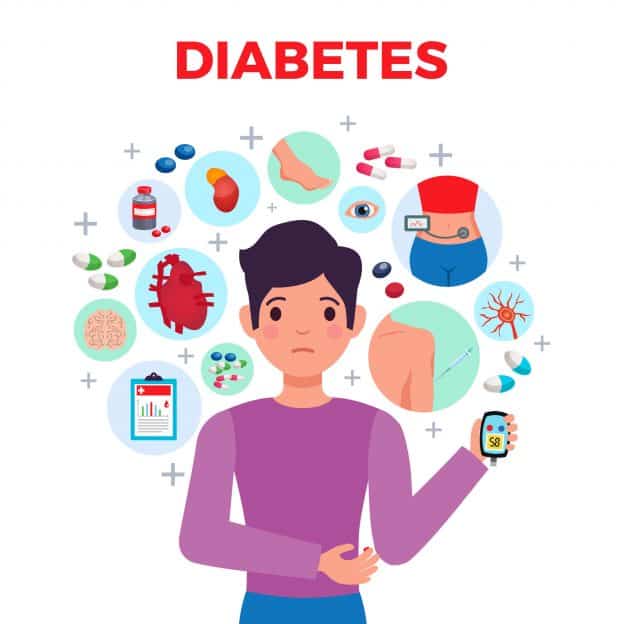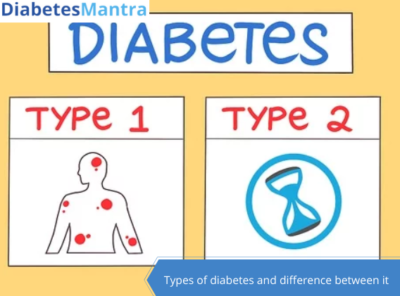Contents
Difference Between Type 1 And Type 2 Diabetes
Generally, a lot of people just know that they have diabetes – and don’t know whether it is type 1 or type 2 or most of them think that they are somewhat similar. But as a word of caution, they should not be confused with each other. And there are some fundamental differences in the treatment of both these conditions which people should be aware of.

What Is Type 1 And Type 2 Diabetes?
The main reason for having type 1 diabetes is the scarcity of insulin in the body. When the pancreas in our body is not able to produce insulin or produces it in lesser quantity than required, this condition is known as type 1 diabetes. Whereas, type 2 diabetes, on the other hand, is a condition where the pancreas creates insulin, however, the cells resist its proper use or there is insulin resistance. In turn, the pancreas creates more insulin to transfer glucose in the cells, however, due to insulin resistance, the glucose eventually builds up in the blood.
Causes of Type 1 And 2 Diabetes
Type 1 diabetes mostly starts in childhood. Its main causes include 1) Genetic factors: If someone in our family tree had diabetes, maybe your father or mother 2) Our immune system malfunction may also play a role in developing type 1 diabetes. In diabetic people with type 1, the immune system mistakes the body’s own healthy cells for foreign invaders. The immune system attacks and destroys the insulin-producing beta cells in the pancreas. After these beta cells are destroyed, the body is unable to produce insulin.
On the other hand, type 2 diabetes has different causes. Diabetic People with type 2 have insulin resistance. The body still produces insulin, but it’s unable to use it effectively. You’re more likely to get Type II if you:
- Are older, especially over age 45
- Are overweight or obese, especially if you have belly fat
- Have a sedentary lifestyle and don’t exercise
- Eat a lot of meat, drink sugary beverages, and don’t eat much fruit, veggies, nuts, whole grains, or olive oil
- Have a sleep problem, or work changing shifts or night shifts
- Have high cholesterol or high triglycerides,
Symptoms of Type 1 And Type 2
Both type 1 and type 2 have similar symptoms, and the eventual impact on the body is similar. If you have type 1 or type 2, you might notice that:
- You pee a lot: As your kidneys try to excrete the excess glucose through urination
- You’re a lot thirstier than usual: As frequent urination starves your body of water
- Blurred Vision: As when blood sugar levels are high for a long time, body water is pulled into the eye lens, causing it to swell.
- You’re a lot more tired than usual: As, under diabetes, glucose which is the key source of energy remains in your blood and is not transported well to the cells
Although many of the symptoms of type 1 and type 2 diabetes are similar, they are present in very different ways:
The symptoms of type 1 diabetes develop quickly, typically over the course of just a few weeks. These symptoms typically show up in childhood or adolescence. However, it’s possible to develop type 1 diabetes later in life.
On the other hand, many people with type 2 diabetes won’t have symptoms for many years. Their symptoms often develop slowly over the course of time. In fact, some people with type 2 diabetes have no symptoms at all and don’t discover they have the condition until major complications arise such as amputation, blindness, heart diseases, etc.
How Type 1 And Type 2 Diabetes Is Tested?
There are certain universal methods to check diabetes including the hba1c test, fasting blood sugar test & random glucose test. They are used for both type 1 and type 2 diabetes. Apart from these, your doctor will advise an Insulin level test to check for Type 1 diabetes and an Insulin resistance test to check for type 2 diabetes. Let’s talk about them briefly: Insulin level test (for type 1 detection)
This blood insulin test tells you the level of insulin in your body. Normally, the level of insulin in our blood stands at 2.5 to 25 ulU/ml. If the test shows an insulin level below 2.5, then you are having Type 1 diabetes i.e low or no insulin production in your body.
Insulin resistance test (for type 2 detection)
If the level of insulin resistance increases in your body, it can lead to type 2 diabetes. You can measure your insulin resistance to identify the severity of diabetes. Checking the insulin resistance involves a very simple formula i.e. insulin resistance level=fasting insulin level x fasting blood sugar level divided by 405.
If the value stands at 0.5-1.49, then the person is not having insulin resistance, while the value between 1.5-2.5 indicates a moderate level of insulin resistance followed by a value of more than 2.5 indicates severe insulin resistance. If a person is having moderate levels of insulin resistance, then diabetes can be reversed in around 6 months to 1 year, while, if the insulin resistance is severe, then it might take a time of 1.5 to 2 years.
Treatment For Type 1 And Type 2
Type I is primarily cured through regular insulin therapy. Since your pancreas is unable to produce insulin on its own, you can inject insulin into your body via insulin injections. Whereas, in the case of Type 2, other treatments such as regular medication, healthy eating, and regular exercise are applicable. That said, Treatment for both Type 1 and Type 2 involved lowering the blood sugar level. Therefore, most treatments for Type II are also effective in treating Type 1 as well.
A Word From MantraCare
Do you want to get rid of diabetes? Join our online diabetes consultation program and reverse your Diabetes naturally through lifestyle changes such as a Personalized Diet plan, Exercise, dieticians, and health coaches.


